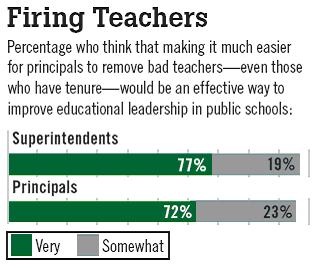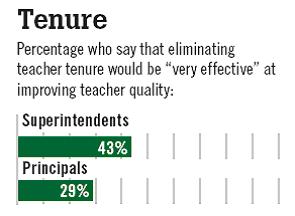

from DistrictAdministration.com
This page is a compendium of items of interest - news stories, scurrilous rumors, links, academic papers, damnable prevarications, rants and amusing anecdotes - about LAUSD and/or public education that didn't - or haven't yet - made it into the "real" 4LAKids blog and weekly e-newsletter at http://www.4LAKids.blogspot.com . 4LAKidsNews will be updated at arbitrary random intervals.
4LAKids: "I was speaking to Mayor Riordan at the summit and he posited that it might not be necessary to eliminate ALL the LAUSD bureaucrats at to shake things up. Just get rid of one of 'em – fire the worst of the worst rather publicly - and the rest may fall unto line! (Riordan tends to have ideas punctuated with exclamation points – it makes him dangerous but I like that about him!) This solution – right out of Gilbert & Sullivan's "Mikado" ("They'll none of 'em be missed…") has a certain resonance. I have candidates of my own …but I'm open to further suggestions!" -smf
According to the National Assessment of Educational Progress, considered the gold-standard test for the nation's schools,
Meanwhile, according to the NAEP,
School officials can't hide behind demographics on this one. The district does have a high percentage of Latino and African American students who generally score lower on standardized tests. But all the urban districts have sizable numbers of minority students. And
Because good education starts with good instruction — a truth too commonly lost in the school reform debate — the top priority is hiring more fully qualified science teachers. That's admittedly a difficult task. Science teachers are at a premium, with too many school districts vying for too few teachers. An urban school district such as
The district's administration — and, more important, the teachers union — should realize by now that half-measures don't work. The solution is simple: Pay top science teachers more. That is anathema, of course, to United Teachers Los Angeles, which insists that the schools pay teachers according to how long they've stayed in the same job rather than how well they're doing or how badly their particular skills are needed.
The district's performance reflects as badly on its teachers as on its students. Ultimately, it's in the union's interests to change its outmoded ways to accommodate unpleasant realities.
►smf: This is an interesting idea. However, are there other large major unionized school districts in the US that pay more for science teachers "based on how badly their skills are needed" ...beyond paying additional for years of experience and/or academic credentials?
• Political reality is in play as Villaraigosa ponders which three
by Howard Blume and Duke Helfand, Times Staff Writers
Crenshaw High, in the historical heart of black South Los Angeles, also sits squarely in Villaraigosa's sights, even though it qualifies far more students for college than nearby schools.
And Roosevelt High, the mayor's alma mater and a symbol of his Eastside Latino roots, also rises to the top of the shortlist, although it is nearly indistinguishable statistically from neighboring schools.
These campuses are top contenders under a new law that allows Villaraigosa to take control of three high schools and the clusters of middle and elementary schools that feed them.
The mayor's office has identified 19 high schools that satisfy the law's conditions, including a requirement that the campuses are in different parts of the city and are among the lowest 20% of schools in
But in making this choice, what else should matter: the extent of the gang problem? the experience of the teaching staff? the number of ninth-graders who go on to college?
The selection will be based on political realities as well as educational needs.
The schools on the likely shortlist are in communities rich with key blocs of voters, including African Americans in
"There is political calculation that goes into this besides underperforming schools themselves," said Jaime Regalado, executive director of the Edmund G. "Pat" Brown Institute of Public Affairs at Cal State L.A. "The mayor needs to placate … the north and south and mine votes for the future."
Villaraigosa insists the choice is not about politics.
"The initiative will have much broader support if it represents a geographic cross-section of the school district," said the mayor, who will select the schools in conjunction with the
The success of the schools picked by Villaraigosa will be a litmus test for the mayor as an educational leader and could have a direct effect on his potential reelection in three years.
The schools Villaraigosa adopts are likely to reap a wealth of resources and money, which could pay for more teachers, improved buildings, new learning materials, dropout-prevention programs and other expert help. His staff is looking at model programs at some L.A. Unified campuses and at local charter schools, and interviews are underway to hire a "superintendent" and staff.
Some suggest these schools couldn't help but improve; Villaraigosa and his aides say they hope their involvement will invigorate schools across the district.
Five high schools seem likely to emerge as front-runners: Crenshaw and Dorsey in
Yet none of the five is among the bottom six campuses in the school system based on test scores, and the Valley schools lie roughly in the middle.
In fact, no Valley high school on the mayor's list rates as low academically as campuses in
Sylmar and Monroe are the lowest ranking of the five, at 38th and 34th, respectively, among 60 L.A. Unified high schools. Both schools, however, are considered strong performers when compared statewide with schools that serve similar students.
A late amendment to the Villaraigosa-backed law approved by the state Legislature this year allowed somewhat higher-performing schools to be included in the mayor's plan, opening up an opportunity for the Valley — a politically important region for any L.A. mayor. And Villaraigosa has promised to choose a Valley high school.
Including Valley schools would send an important message in a part of the city where there has been strong sentiment to secede both from the city and the school system, said Brendan L. Huffman, president of the Valley Industry and Commerce Assn. "It shows recognition that improving education in the Valley is part of his vision and a priority for his administration."
If Villaraigosa chose schools strictly on academic shortcomings, he would focus first on
Other statistics tell a similar tale. A study by UCLA-affiliated researchers of the class of 2004 concluded that out of every 100 Crenshaw ninth-graders, 24 qualified for
All of these lower-performing schools are predominantly Latino except Washington Prep, where African Americans are the majority.
Villaraigosa has an incentive to choose a black-majority campus, because African American voters represent another key constituency that backed him in last year's election.
In addition, his campaign to take over the school district strained his relationship with some influential African American leaders, who did not uniformly support it.
One such leader dismissed Villaraigosa's interest in Crenshaw High as "ethnic symbolism." But others commended Villaraigosa for showing so much interest in African American children, who make up just 11% of L.A. Unified's 708,461 students.
Some community leaders also said that educating low-achieving black students poses a unique challenge that deserves special focus.
At Crenshaw, African Americans account for 66% of 2,330 students; at Dorsey the percentage is 57% of 2,000.
"He is sending a conciliatory message that he is going to continue to do what is right," said the Rev. Eric P. Lee, executive director of the Southern Christian Leadership Conference of Greater Los Angeles. "He's trying … to create model reform in representative areas."
Not everyone is won over.
Crenshaw-area resident Carma Chinyere, whose mother teaches at Crenshaw High, sees the mayor as an unwanted interloper in a school community that already is trying to make things better.
"He should be asking, 'What do you need?' " said Chinyere, who also teaches in the school district. "There are other pressing issues in the city that need his time and attention."
If Villaraigosa chooses one largely African American high school in South L.A. and one high school in the Valley, then political realities suggest the third school must be in a traditionally Latino enclave.
That brings the mayor to Roosevelt, the school from which he graduated after dropping out of a parochial school.
Overall,
Nearly all of its 5,000 students are recent Latino immigrants, and the school is ripe for improvement because community groups have banded together, forming the Boyle Heights Educational Collaborative, said activist and school board candidate Luis Sanchez.
The mayor should choose "a school that has some form of social capital around it," said Sanchez, executive director of InnerCity Struggle, an Eastside grass-roots organization involved with education and housing issues.
What success will look like is unclear. Villaraigosa has spoken in broad terms of a partnership in which the entire community — especially teachers and parents — has a meaningful say in running schools. The mayor also has expressed impatience with slow change and about the necessity for every student to be proficient or advanced academically, as the state defines it.
The depth of the challenge requires citywide commitment, said UCLA education professor Jeannie Oakes.
"It's important that whatever schools he chooses, he develops some strategy for engaging all of Los Angeles, so that we can all feel invested in the mayor's experiment," Oakes said.
The mayor and his advisors are holding meetings around the city to make presentations, answer questions and elicit ideas from parents, teachers and others. These efforts included last weekend's "education retreat," which brought together academics, community organizers and others.
The mayor's staff had talked about announcing two of the three school clusters this month, but the choice might be pushed back. The law specifies a start date of July 1 with the third cluster beginning the following year. The entire process could be derailed or delayed by ongoing litigation challenging whether the mayor's involvement is constitutional.
Outgoing L.A. schools Supt. Roy Romer worries about an us-versus-them mentality that could tempt Villaraigosa's team to make his schools look good compared with the rest of the school system — or worse, undermine systemwide reforms that have begun to show results.
"I've worked for six years to bring unity" to the school district, Romer said. "We need to have the mayor put his arm around the entire district, to own it all."
At a teachers union gathering last week, the mayor's senior education advisor, Ramon C. Cortines, said that is the goal.
"These are not going to be exclusive schools," Cortines told the teachers. "These are not to be given special treatment. We need to deliver resources to all schools."
WHICH WILL IT BE?: Three of these 19 high schools would be overseen by Mayor Antonio Villaraigosa under a new law scheduled to take effect in January.
SOUTH LOS ANGELES:
• Crenshaw
• Dorsey
•
•
• Locke
• Manual Arts
WEST/CENTRAL LOS ANGELES:
•
•
•
•
EAST LOS ANGELES:
•
•
•
•
•
• Grant
•
• Polytechnic
• Sylmar
Source: Mayor Antonio Villaraigosa's office/Los Angeles Times
• Para el contacto adicional de la información entrar en contacto con por favor a Donna Nevel en el Centro de Familias Inmigrantes :: 20 West 104th Street :: New York, NY 10025 :: phone: 212-531-3011 :: fax: 212-531-1391 :: email: info@c4if.org :: http://www.c4if.org
• For further information contact please contact Donna Nevel at the Center for Immigrant Families :: 20 West 104th Street :: New York, NY 10025 :: phone: 212-531-3011 :: fax: 212-531-1391 :: email: info@c4if.org :: http://www.c4if.org

